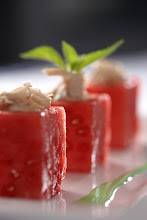
The Scoop on Turkey
And Other Stories from the Original Harvest Table
By Tony Conway, CMP
Sometimes, our research takes us to unexpected places. Recently, a client asked us to prepare an authentic Thanksgiving dinner for a gathering of twelve. In order to get the details right, we schooled ourselves in everything Pilgrim. Through reading widely and surveying unspoiled miles of video footage, we learned that the first harvest dinner didn't, in fact, include many of the dishes that we typically consider traditional Thanksgiving fare. We also discovered that we probably wouldn’t even be celebrating Thanksgiving Day if it weren’t for a woman named Sarah Josepha Hale.
Until the mid-1800’s “Thanksgiving Day” was considered a religious holiday celebrated solemnly through fasting and quiet reflection. In 1854, Sarah Josepha Hale, a savvy, trendsetting, editor of a widely-read women’s magazine, stumbled upon a letter written by a pilgrim named Edward Winslow. Winslow’s letter included details of the original harvest feast of 1621. Hale was immediately smitten by the story of how a group early colonial settlers and a tribe of Wampanoag Indians gathered peacefully in Plymouth, Massachusetts to feast on juicy wild fowl, venison, cornbread, and a bounty of fruits and vegetables.
Around the same time, a history book written by the mayor of Plymouth Plantation, William Bradford, resurfaced. Bradford’s book also contained details describing the original harvest feast of the early settlers. The book was stolen by looters during the Revolutionary War and remained lost until around the same time that Sarah Hale’s interest in Colonial life piqued. Reading these two written accounts launched Hale into action.
Sarah Hale became determined to keep this part of history alive. Since she was a respected editor at a popular women’s magazine—she was just the person to make that happen. In her magazine, Hale wrote appealing articles about roasted turkeys, buttery mashed potatoes, and fiery red cranberry sauce. In 1858, Hale even petitioned the president of the United States, Abe Lincoln, to declare Thanksgiving a national Holiday. Though Hale’s campaign cemented Thanksgiving Day as a national holiday, the Thanksgiving recipes she zealously wrote about were not entirely representative of the feast of 1621.
Though turkey is the main menu item that comes to mind when many of us think of Thanksgiving dinner—it may not have actually been served at the original harvest feast of 1621. We do know that some type of “wild fowl” was served; however, “wild turkey” was not named in either of the first hand written accounts. It is more probable that the “wild fowl” brought back by the four pilgrims sent out to hunt for the harvest day celebration were seasonal waterfowl such as duck, geese, and cranes. We know for sure that venison was named as a meat (in fact, King Massasoit of the Wampanoag Indians presented five deer to the Pilgrims as a harvest gift). Having said that, wild turkey may have indeed been a dish at the harvest feast of 1621, we just have no written record of it.
We know for certain that potatoes were not served because they had not yet been introduced to the colonists. We also know that corn on the cob would have been absent from the table because the Indian corn that was available to the Pilgrims was only good for making cornmeal, not for eating on the cob. Pumpkin pie would have also been missing from the menu since no butter or flour was available for making pie crust. Instead, they may have eaten stewed or boiled pumpkin sans crust. Even if the colonists did possess the necessary ingredients for pie making—they had no oven for baking. There would have been no cranberry sauce either. Only a small amount of sugar—critical for making cranberry sauce—had been transported via the Mayflower. When it came time for preparing the first harvest meal, their limited sugar supply would have been long gone. Finally, the early pilgrims did not have pigs so anything involving ham or bacon would have been omitted from the harvest table.
With so many of the traditional Thanksgiving items off the table you may be wondering what the colonists and Wampanoag Indians did eat at the harvest feast of 1621. In addition to the aforementioned venison and wild fowl—rabbit would have also been served along with grapes, plums, walnuts, chestnuts, onions, pumpkins, beans, lettuce, radishes, leeks, parsnips, carrots, cornbread and olive oil. Although fish was usually considered too “ordinary” to be served at a fine feast—some lobster, clams, or cod may have also been eaten.
It may surprise you to learn that the food they prepared wasn’t bland—in fact it was quite the opposite. Pilgrims cooked with many spices including garlic, cinnamon, ginger, nutmeg, pepper, and dried fruit—they also slow-roasted their meat on a spit. Pilgrims were assigned to patiently turn the spit for hours at a time until the meat was evenly done. Though the pilgrims had fewer resources at their fingertips (no ovens and no refrigeration) they made tasty dishes by using a lot of good ole fashioned improvisation.
Though Sarah Josepha Hale may have taken some creative liberties with her interpretation of Thanksgiving dinner—we must salute her for bringing this special holiday to the fore. Besides, if it weren’t for her, maybe we’d forget to be grateful. Maybe we’d tear through the Halloween candy corn at Mach speed straight through the Christmas wrapping paper and into the New Year without taking a breath—without pausing to remember the importance of coming together for a home-cooked supper composed of the very same ingredients that were found at the original harvest table of 1621—heaping bowls of gratitude and platefuls of fellowship.





No comments:
Post a Comment